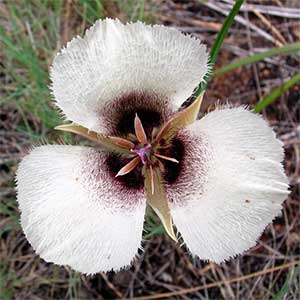Calochortus umpquaensis
Calochortus apiculatus
Umpqua mariposa-lily
Baker's mariposa-lily, point mariposa-lily, point-tip mariposa lily, pointedtip mariposa lily, three-spot mariposa-lily
not branching, straight, often scapelike, 2–3 dm, glabrous or glaucous.
usually not branching, straight, scapelike, stout, 1–3 dm.
basal solitary, clasping;
blade narrowly lanceolate, hairy, adaxially hispid, abaxially glabrous, sometimes glaucous. Inflorescences 1–several-flowered;
bracts 2, suboppo-site, narrowly lanceolate.
basal 1–3 dm × 5–15 mm, usually shorter than stem.
subumbellate, 1–5-flowered;
bracts 2–several, lanceolate to linear, unequal, 1–5 cm, apex acuminate;
peduncle stout, becoming strongly deflexed in fruit.
erect;
perianth open, campanulate;
sepals lanceolate-acuminate, ca. 2 cm;
petals white to cream, with dark purple-black, pentagonal to lunate blotch, broadly oblong to obovate, 3.5 cm, bearded, adaxial surface typically minutely papillose, margins erose;
glands transversely oblong-lunate, slightly depressed, with 0.7–1.4 mm-wide band of short dendritic hairs distally, hairs surrounded by lime-green coloration and purple striations;
anthers lanceolate, apex acuminate.
erect or spreading;
perianth yellowish white, sometimes streaked with purple, open, campanulate;
sepals shorter than petals;
petals oblong-lanceolate, clawed, adaxial surface densely hairy, margins fringed laterally and moderately bearded on proximal 1/2 distal to claw with slender, flexuous hairs, apex acute or obtuse;
glands short, nearly round, depressed, typically bordered proximally by dark-colored, deeply fringed membrane, adaxial surface covered with short, thick hairs;
filaments shorter than or equaling anthers;
anthers lanceolate, apex long-apiculate.
nodding, 3–5.4 cm.
nodding, 3-winged, ellipsoid, apex acute.
2.8–3.5 mm, with inflated bulbous crest and hollow lateral ridge.
light brown, irregular.
= 20.
= 20.
Calochortus umpquaensis
Calochortus apiculatus
Of conservation concern.
Calochortus umpquaensis is known only from Watson and Ace Williams mountains on both sides of the Little River, Douglas County.
(Discussion copyrighted by Flora of North America; reprinted with permission.)


